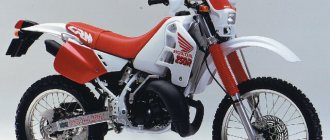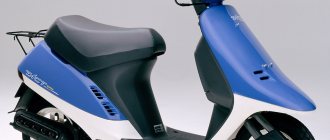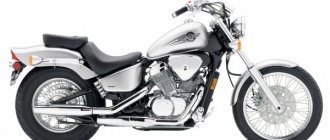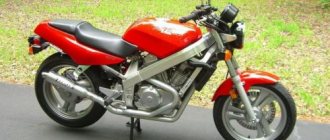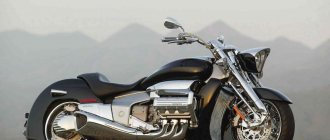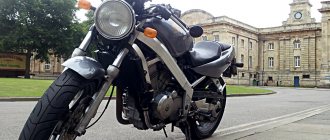For whom
Here are the main features of the motorcycle:
- the same engine as the Honda HX 650 Dominator;
- steel frame;
- average weight - 176 kg, including fuel.
The motorcycle is well suited for those who have already tried models with fewer cubes and want something more serious. This is a good bike for city riding and light off-roading, but it is completely unsuitable for serious off-road use, if only because its suspensions are not designed for this.
Engine
The FMX 650 is equipped with a four-stroke single-cylinder engine. The latter has four valves. The fuel supply system is carburetor. The unit is cooled by air, and the working volume of the model is 644 cm³.
The limit values are as follows: at 4500 rpm, torque is 52 Nm, and power at 5750 rpm is 38 hp. The motorcycle accelerates to 100 km/h in 5-6 seconds, and its top speed is 155 km/h. In principle, this is not bad for an average model that does not pretend to be anything, which the FMX 650 was definitely not planned for.
Review of the Honda FMX 650 motorcycle
The season on FMX is almost over. 4000 km covered. Not much, but I also have more than one motorcycle. In general, I liked the motorcycle, despite the modest power of 37.5 hp. The engine is certainly old, but very reliable. This is used on Dominator, XRL, SLR. But FMX was also strangled due to environmental standards. The Honda confidently accelerates to 150 km/h, if you bend down and be patient it will go all the way to 160. I think that the motard is no longer needed. Acceleration to hundreds is 5.8 seconds, not great, but none of the cars have ever made me run from a traffic light. Although it is clear that the 55AMG Ferrari Modena and other charged four-wheeled vehicles will tear me apart from the start like a hot water bottle. The weight of 163 kg is prohibitive for such equipment (although the Yamaha XT 660 went even further, 172 kg) But the landing is quite low, so the weight is not felt much. The clearance is quite enough to overcome curbs, but when driving on stairs you have to be careful, I used the lower shock absorber mount twice myself. What else. It takes turns amazingly, I think no worse than a good road driver. I rode it on a karting track, the impressions were super, I even grabbed it with the footpegs, costs like a glove. The fork is an excellent upside-down one, quite rigid, and the rear shock absorber is also rigid, although it is possible to adjust. The device is quite suitable for road hooliganism. You can ride on the rear wheel as much as you like, the balance is quite easy to find, and a dry sump and oil in the frame guarantee that oil starvation will not occur. with a brush. The steering wheel is quite narrow by cross-country standards, so it’s convenient to dart between cars. The passenger is transported quite normally, there is no discomfort, the seat is comfortable and it has almost no effect on the dynamics. There are not many vibrations at all, up to maximum speed, visibility in the mirrors is excellent. The tank is of course small, 11 liters, after 130 km of mileage I turn on the reserve, the equipment is still rather meager from the XL of the late eighties. There is practically no space under the saddle, only a standard set of keys fits. In general, the motorcycle is not for long-distance driving, and because of the stiffness of the suspension, you get tired on it quickly. A typical city vehicle. The plans include installing forward flow, otherwise the standard silencers clearly choke the motorcycle. But in principle, I’m happy.
I bought a Honda FMX 650. I rode it for two days... I really liked everything. The locomotive traction. And the chassis is generally super. RAIL. NO stairs or holes. Probably the roads have been improved. But no, I got on the VFR. everything is fine. pits, holes, stairs…. Happy as an ELEPHANT. Handling—I couldn’t even think how convenient the device would be around the city. Together with my son. Over curbs and through traffic jams. Super on sports, don’t even try it.
There is one minus for now. Of course, the engine is a little underpowered for the road. Although up to 100-120 you feel comfortable. Then there is little dynamics. But on the other hand, in traffic jams and on poor surfaces, the traction from the snow is POORIOUS.....Turn around the comfort - due to this - SUPER. It doesn’t bother you around the city, and you even get into some kind of COURAGE. The engine is very flexible and friendly. no grabs. clear operation of the box. Chassis without any discussion at all. The sound is quiet BASS. I really like it. A sort of small TRACTOR.
Dimensions and weight
The bike is quite tall – 1157 mm. Its width reaches 823 and length – 2151 mm. Wheelbase dimensions – 1490 mm. The seat height of the FMX 650 is 875 mm. The weight of the bike without fuel is 165 kg. The volume of the tank is insignificant - 11 liters. Of this volume, 3.8 liters are reserve. The average consumption per 100 km is quite high here: 5.5 liters.
Honda FMX650; Honda SLR650; Honda SL230; Honda CRM250R-2
text from Motorreview No. 9, 2006:Vladimir Zdorov, Denis Panferov (Dean),
photo:
Dmitry Ivaikin
Husqvarna SM610 Dual: 2006 onwards, 576 cm3, 53 hp, 170 km/h, $ 10500 Honda FMX 650: 2006 onwards, 644 cm3, 37 hp, 155 km/h, $9900
The cost of exotic brands that until recently seemed exorbitantly inaccessible has become quite comparable to Japanese mass products. But how different does fine Italian cuisine taste from Japanese fast food?
About the benefits of diet How everything is relative! For its 650 cm3 volume, Honda has a very good figure - 163 kg. For a woman, even according to the specific preferences of the editor-in-chief, this is a bit much, but for a medium-sized enduro with a civilian orientation it is a good indicator. But compared to the 142 kg Husqvarna, this is already perceived as overkill. Next to the FMX 650, the former Swedish citizen, who has accepted Italian citizenship, looks like a thoroughbred greyhound, impatiently moving his long paws in anticipation of the “Face” command. Honda seems, albeit somewhat short-legged, but a bull terrier standing firmly on its feet. Still, the work of a motorcycle journalist sometimes presents very funny moments that give completely new points of reference, and facets that shine with countless colors of the rainbow of new views on familiar things. I remember when I first saw the Honda FMX650 at the Munich 2005 exhibition, I looked sarcastically at the very mediocre characteristics, especially grimacing when I saw the figure of 37 hp...
But even being cynical to the point of a week of unwashed “family boots,” I was forced to note the overall elegance and “airiness” of the new product, designed in the spirit of the supermoto style popular in Europe.
The main revelation of the Husqvarna SM610 Dual was the downright diabolical braking potential of the device. Only the most sophisticated designer (or makeup artist?) can complain about the lack of radial mounting of the brake caliper and radial brake cylinder, and then only for aesthetic reasons - the brakes of the SM 610 Dual are the envy of nine out of ten thoroughbred sportbikes. Very powerful, empathetic and informative. In addition, the four-pad Brembo caliper is absolutely not prone to fading of braking force even after intensive use on the track. A solid five plus. Reinforced hoses are already included in the basic configuration - there is simply nothing to improve...
The narrow seat, like a gymnastic bar, may scare away buyers accustomed to daily runs of up to 1000 km. However, there are no flaws in ergonomics: a natural posture, a slight shock load on the spine when riding on uneven surfaces, footpegs located where they should be, and a handlebar of a “comfortable” height - everything works to reduce driver fatigue and increase the comfort of driving a motorcycle . It is obvious that when designing the 610th Husky, the designer worked after the ergonomist, and not vice versa, when they try to somehow fit the driver into the beautiful layout of the concept. The energy intensity of the suspension is enough for confident driving up stairs in both directions and jumping off half-meter curbs. The engine below is reliably protected by two strong frame pipes, and the ground clearance is such that it is very difficult to find an obstacle that will reach there. A real city motorcycle.
Funmoto Taking the Honda FMX650 out of the sterile environment of the motorcycle showroom, the first thing I was pleased with was the excellent comfortable pilot’s seat, which, unlike Husqvarna, is not located at the height of a five-story building. Let me be clear right away - Honda never tried to position the FMX650 model as a supermoto, coming up with its own definition - funmoto. Moreover, this “fun” here does not lie at all in the amazing power. There is a different philosophy here - maximum convenience for city driving.
And what kind of power can we talk about if the engine is taken as a basis from the Dominator model, pictures of which I looked at while still in high school. Moreover, the engine was noticeably derated, it seems, not at all for the sake of decent traction at the bottom. Modern environmental requirements, alas, are not friendly to carburetors. Vibrations, so typical of single-cylinder engines, bypassed the FMX650, the mirrors remain fully “working” up to a relatively low maximum speed. With my body not conforming to the laws of aerodynamics, the speedometer showed 150 km/h several times. Not to say that such a value is very exciting, but, on the other hand, with an absolutely straight landing, it’s unlikely that more is needed. Another question is that the dynamics of acceleration itself, especially after 100 km/h, evokes boredom, making you regret that you didn’t take some interesting reading with you to the test. We need to somehow occupy ourselves until the motorcycle finally accelerates...
In this situation, the Husqvarna SM610 seems like just a rocket, periodically trying to go into wheelie from second gear during normal acceleration. The FMX 650's limit of 150 km/h is achieved in one breath; if you continue to persist, you end up with a quite impressive 170 km/h. But it is important to note one aspect. If the Honda, even at its maximum speed, is perceived as an ordinary road driver, albeit with not the most successful wind protection, then the long-legged Italian with its almost cross-country suspension moves sways in every possible way, involuntarily forcing it to “cover up”. On a flat road it gets annoying. But as soon as the surface approaches Russian realities - that is, it begins to abound with holes and bumps, then everything becomes much more interesting - Husqvarna easily swallows even the most obvious potholes and irregularities. Honda also goes very well on rough roads, but its capabilities are not so great. In a direction that’s completely trashed, you still have to slow down on the “Japanese” - at some point the shock absorbers completely select their stroke, the motorcycle begins to jump and stray from the trajectory. To achieve the same effect on a Husqvarna, you'll have to take it to a trials track.
Both devices do not shine with seat comfort, but on the Honda it is much more “civilian”. At the same time, the narrow, toilet paper-like spacer between the frame and the driver, which in Italian, oddly enough, is also called a seat, surprisingly does not bother you, and if it loses to the FMX650 in comfort, it is only a little. The stock Husqvarna muffler is surprising in only one way - how did it pass through the tough sieve of EU noise standards? On the FMX 650 the noise produced is fine, there is practically none. But, looking at the double muffler pipes, with their dimensions capable of strangling a five-liter sports car engine, you can determine with unambiguous confidence where exactly a good dozen horses are “wasting away.” Ecology, coupled with strict European exhaust noise standards, castrated the Dominator engine, known for its healthy aggression. But no one is forbidding the installation of direct flow - I’m sure the picture of power output will seriously change...
Surprising but true. Despite positioning its new product as a funmoto, a kind of first motorcycle for beginners or girls, Honda handles more like a professional asphalt racing machine. With a very interesting feature - the motorcycle does not care what style of piloting you profess - supermotard or sportbike - it will hold even the deepest inclinations equally confidently. This is largely due to the very moderate suspension travel.
Husqvarna is much stricter in this sense - the hang off technique is not suitable for it, here the emphasis is very clearly placed on super-Motard cornering. In the end, it turned out that I had the best lap time on the much less powerful FMX than on the almost sporty Husqvarna! After all, the Honda in its handling is practically no different from ordinary road motorcycles, while the impressive Italian is much more demanding of the pilot’s technique.
What was most striking was that the Honda FMX, which at first seemed unreal even in first gear, began to perform in second gear at the end of the test. Still, how good it is that the world is not ruled by raw power alone. The brakes of the “Japanese” were a little disappointing; in principle, they cope with their job and, perhaps, would not even have caused any comments from me if I had not previously ridden a Husqvarna.
The rather low seat of the FMX provides an excellent opportunity to introduce even the smallest girls to the world of motorcycles; on the other hand, it does not provide the most outstanding ground clearance. It will be quite sufficient for storming city curbs; there are unlikely to be any difficulties when driving up stairs. But at the karting track, I quickly “selected” the gaps between the driver’s footrests and the asphalt. But here this should be taken as a price for convenience; after all, I can hardly imagine the FMX650 spending most of its time in such tilts. The Honda dashboard unpleasantly struck me with its asceticism, if not poverty. The miniature speedometer alone, which by the way is quite poorly readable, gives the feeling that it was removed from some ancient device from the mid-80s. Somehow all this does not look very respectable against the backdrop of the Husqvarna measurement and computing center.
Fusion One of the most popular trends in modern cuisine of especially expensive and refined restaurants is called fusion, that is, an absolutely incredible mixing of seemingly completely incompatible cuisines of different nations. Let's say a Mexican burrito with cranberry sauce in a fried banana with cognac infusion. To be honest, I have never tried it, but they say it produces an amazing range of flavors. In the world of motorcycle technology, this happens all the time now. The Husqvarna SM 610 Dual is a typical example of an athlete who has perfectly adapted to civilian life and has hardly lost his steely muscles. Honda FMX650 is a very comfortable, practical motorcycle for the city, externally looking like a 100% supermoto and not without, despite not the most outstanding power indicators, a fair share of pepper.
The “Italian” has decent power – it easily propels the motorcycle to the rear wheel from second gear and allows the speedometer to easily show 170 km/h, killer brakes. The disadvantages are almost a single seat, noticeable vibrations, a tiny gas tank volume and a lot of questions about the reliability of the device. Honda has its own trump cards - low (for this type of motorcycle) seat height. Minimum vibrations, 100% supermotard design and unquestionable reliability. However, more than one horse’s head is bent in the depths of the beautiful exhaust system, and the maximum speed of the motorcycle will allow almost any owner of a domestic car to abuse you (and in a perverted form). The gas tank here is even smaller! It is a pity that, as in the fashionable fusion movement, it is impossible to mix the advantages of both motorcycles and, having gotten rid of their shortcomings, bring out a new breed of device that suits absolutely everyone. But maybe it's for the better? After all, when there is no alternative and no choice, life becomes gray and boring, just like the view from the window of a car stuck in a traffic jam...
Options A “sports” package for the Honda FMX650, which includes water cooling, an increase in 16 horsepower, increased ground clearance, increased suspension travel, inverted front forks, on-board computer and Italian design for only $600? This is a very profitable offer. And let Husqvarna be written on the tank instead of Honda – there’s nothing wrong with that.
Denis Panferov I will leave observations about the ability to ride on the rear wheel, as well as in hang off, for the manic Zdorov, apparently trying to put even the chair in which he is watching “Good night, kids!” up to his knee. I bought the Husky quite consciously; I always wanted to have, on the one hand, an uncompromising racing machine, and on the other hand, a motorcycle suitable for everyday travel. The past season confirmed the logic of the choice I made. Practice has shown that 1,500 km a day on a narrow seat that initially seemed completely unsuitable for such exercises is quite feasible for a mere mortal... The design of the motorcycle is very brutal and aggressive. The grille on the headlight and the shape of its shield generally became the founders of a new trend in the style of enduro and supermoto, which already exists. The light from the headlight is easily enough for driving at night on federal highways, but it’s better not to go on broken, narrow and winding roads through the forest at night - the stock “light” is no longer enough in such conditions. The readability of the rear optics and turn signals is excellent. Visible both during the day in the sun and at night.
The strange thing is the presence of two different keys. One unlocks the tank, the second is needed for the ignition switch, steering wheel lock and helmet lock. Why the tank needed its own special key is not yet clear to me. The large-diameter hollow axles of the wheels make the procedure for installing sliders on them accessible even to a fifth-grade student. An aluminum crankcase protection sheet may only be needed for serious off-road use, which on 17” wheels shod with road tires is the stuff of comic books from glamor magazines.
The dashboard amazes with its functionality and sophistication. Speedometer, odometer, clock, tachometer, maximum speed blinker, service interval and oil change indicators, voltmeter - this is an incomplete list of functions for the average user. If you go into the service menu section, you can also find adjustment of the speedometer to the diameter of the front wheel, a digital tachometer, laptimer and a sea of other “useful” functions. But this supercomputer is controlled by just ONE button, and, as befits any Italian electronics, it is buggy at the level of early versions of Windows. You have to reset it to zero about once every couple of thousand kilometers after another “freeze”. The blue backlight of the screen at night looks very beautiful and does not distract from reading the tidy. As for the skyscraper seat height, you get used to everything sooner or later. At the end of the season, I will note that I simply stopped paying attention to it. And in general, over the past 10,000 kilometers I have never regretted my choice, having gone, for example, on my own to Crimea (Well, who would doubt it - approx. Zdorov) .
options
| Husqvarna SM 610 Dual | Honda FMX 650 | |
| Year of debut/year of release | 2005/2006 | 2005/2006 |
| Dry weight | 142 kg | 163 kg |
| Curb weight | 158 kg | 181 kg |
| Length Width Height | 2080/820/1190 mm | 2150/823/1157 |
| Base | 1485 mm | 1490 mm |
| Seat height | 910 mm | 875 mm |
| Ground clearance | 245 mm | 216 mm |
| Gas tank volume | 12 l | 11 l |
| Front fork pitch/reach | n. d. | 29.6°/97 mm |
| Engine | 576 cm3, 4-stroke, 1-cylinder, DOHC, liquid cooling | 644 cm3, 4-stroke, 1-cylinder, DOHC, air-oil cooling |
| Bore/Stroke | 98/76.4 mm | 100/82 mm |
| Supply system | carburetor | carburetor |
| Compression ratio | 11 | 8,3 |
| Power | 53 hp at 7000 rpm | 37 hp at 5750 rpm |
| Torque | 38.3 Nm at 5300 rpm | 52.3 Nm at 4500 rpm |
| Transmission | 6-speed gearbox, multi-plate wet clutch, chain | 5-speed gearbox, multi-plate wet clutch, chain |
| Frame | tubular | steel |
| Front suspension | telescopic, inverted type Ø 45 mm stroke – 250 mm, adjustments – rebound, compression, preload | telescopic, inverted type Ø 45 mm, stroke – 218 mm, adjustments – rebound, compression, preload |
| Rear suspension | pendulum, monoshock absorber, stroke – 250 mm, adjustments – rebound, compression, preload | pendulum, monoshock absorber, stroke – 186 mm, adjustments – rebound, compression, preload |
| Front brake | disc Ø 320 mm, 4-piston calipers | disc Ø 296 mm, 2-piston calipers |
| Rear brake | disc Ø 220 mm, 1-piston caliper | disc Ø 186 mm, 1-piston caliper |
| Front wheel | 120/70–17 | 120/70–17 |
| Rear wheel | 150/60–17 | 150/60–17 |
| Maximum speed | 170 km/h | 155 km/h |
| Acceleration time to 100 km/h | 4.8 s | 5.8 s |
| Average fuel consumption | 7.4 l | 6.9 l |
Chassis and brakes
The frame is made of steel. The design is quite good. The color scheme of the bike looks attractive with a combination of bright red and black colors and, combined with the intense, growling noise of the engine, makes a strong impression.
The wheels are spoked, with a somewhat atypical arrangement of spokes. The handlebars are quite wide, which is convenient since the motorcycle has an almost upright riding position. Whether the seating itself is comfortable is perhaps a question, but for a motorcycle of this class this is an acceptable solution.
The rear suspension is progressive and pendulum type. It is equipped with a monoshock absorber. Its stroke reaches 186 mm. The front suspension is provided by an inverted telescopic fork. Its dimensions are 45 mm and its stroke is 218 mm.
The FMX 650 has a single 220mm disc for the rear brakes. It is assisted by a single-piston caliper. At the front, there is also one disc in this capacity, but it reaches 296 mm, and it is supported by a two-piston caliper.
Latest posts Popular The most interesting motorcycle news
you are reading the most popular news you are reading all the news you are reading the latest news read the most popular read all the news read the latest news
True, after such a mark appears on the speedometer, the engine begins to run out of steam quickly, and at high speeds quite unpleasant and clearly noticeable vibrations arise. However, this is a feature of all single-cylinder engines with a significant cubic capacity - for example, the BMW F650 model begins to vibrate at the top no worse, so it is unfair to talk about a disadvantage as a result of the sensation of vibration of this particular model. At the same time, the acceleration dynamics of the engine are indeed very good, and the dry weight of just over 160 kilograms makes it relatively easy to handle.
The Motard is a motorcycle intended for the city (if you do not remember its original sporting purpose). This fully justifies the Honda FMX 650, despite the considerable weight typical of motorcycles of this class and a modest tank designed for 11 liters. By the standards of the class, this motorcycle also has a fairly narrow handlebar, thanks to which you can easily squeeze between numerous cars in the city, and the seating position turned out to be quite comfortable. True, the complete lack of wind protection, narrow suspension and small power reserve can, however, limit the range of use of the FMX 650 model in the city and its surroundings.
It is difficult to give a definite answer as to what actually is the reason for the lack of commercial success of this model. It is likely that motards are generally a rather specific type of equipment, as they say for an amateur, and at the time of sale the new FMX650 cost quite a lot. The fairly large mass was also able to make some adjustments, although due to the proper weight distribution, the weight of this vehicle is practically not felt; it is really easy to control, especially if the motorcyclist is able to confidently reach the ground with his feet.
As an exclusively urban vehicle, the Honda FMX 650 is quite good, but it still cannot be called ideal. If you want to choose a motorcycle that can bypass all traffic jams in the city, you can choose other models with higher performance. The only thing that most competitors probably won’t be able to do is drive along curbs and stairs. True, not every driver will be able to do such a trick. Otherwise, there are enough bikes that are no worse for getting around the city, and to some extent maybe even better.
